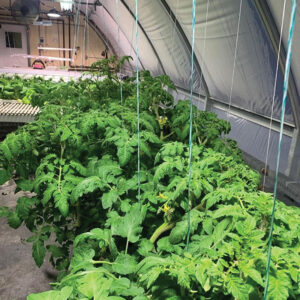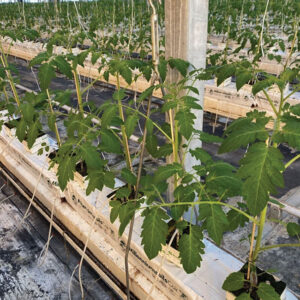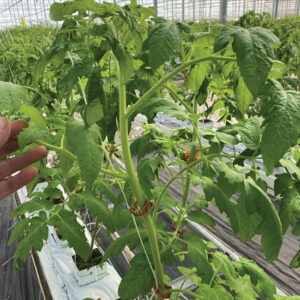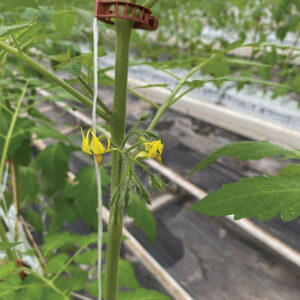
Features
Managing winter greenhouse vegetable crops
Part one: Tomatoes
October 30, 2023 By Dr. Mohyuddin Mirza
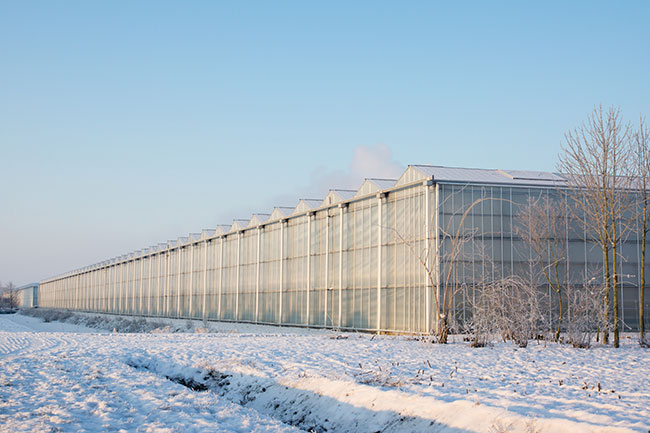 In the winter months when lower light conditions in the greenhouse prevail, plants can become too vegetative.
Photos: © ph2212 / iStock / Getty Images Plus
In the winter months when lower light conditions in the greenhouse prevail, plants can become too vegetative.
Photos: © ph2212 / iStock / Getty Images Plus Growers follow different cropping schedules for cucumber, tomato and pepper. Cucumbers are grown two or three crops a year, however, I noticed that they are shifting to two crops, January to end of May and June to end of October or early November. The growers using supplemental lights generally grow year-round. Many adjustments are being made in cropping schedules based on energy prices which include delaying the seedlings planting to late January and early February. Most of the growers now order the seedlings in advance to be delivered for the desired time period.
It is important to note that three major greenhouse vegetables, cucumbers, tomatoes and peppers are high light crops having a Daily Light Integral (DLI) of between 22 to 30 moles/day. DLI is calculated the light intensity in micromoles/m2/second and duration of the light and it provides a measure of Photosynthetically Active Radiation (PAR).
What to watch for during early spring?
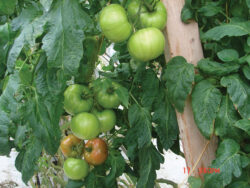
Low light and unlimited water and nutrients can make the plants grow fast.
Photos: Dr. Mohyuddin Mirza
First thing to remember is that you are laying the foundation of the tomato crop to harvest for next 36 to 40 weeks. What is being done in terms of all the inputs managed properly your crop should look like the image above.
Because of lower light conditions in early spring, growers must ensure that plants do not become too vegetative. Low light combined with unlimited water and nutrients can make the plants grow fast and stretch thin and spindly. The following series of pictures, featured on the next few pages, explain what happens if tomato crops in early spring are not looked after properly.
- A very vegetative crop. Thick stems, strong tops and short internodes. Large fruited variety.
- A stretch in stems, relatively thin, flowers not open yet, cocktail variety. Stem elongation due to low light and warmer temperatures.
- A well-balanced crop.
- A well-balanced crop showing good quality cluster and strong flowers. Bumble bees were active in this case.
Strategies for tomato crop – Early spring, January to February
Plant Focus
- Most growers bring in about 30-days-old seedlings which have seven to nine sets of leaves and first cluster visible but flowers have not started opening. Once seedlings are set on the growing medium, the roots will like to go into it and within couple of days, the plants cannot be pulled out. The focus is to let the plant establish by producing roots, that is a vegetative direction. But, due to unlimited water and nutrients, the plant can become more vegetative. One practice that I recommend is to let the plants stay on the plastic surface until the first cluster flowers start opening and third cluster buds are visible. The Electrical Conductivity (EC) of the nutrient solution can be raised up to 4 mS/cm2 and let the growing medium EC increase to around 6 mS/cm by adding additional potassium.
- Let plants produce good, dark green, well-expanded leaves and strong trusses and flowers. Tomato plants produce three set of leaves and one cluster per week and speed of flowering depends on light, adequate CO2 leaves, day and night temperatures and balanced nutrition. Limit the number of fruits to four or five in beefsteak varieties. Entire cluster can be pruned if the quality is poor.
Target temperatures
- Growing medium temperature 18 to 20°C for good root development
- 24 hours average temperature around 20°C. Some growers prefer an average of around 18°C. Depending on light levels.
- Grow pipe temperature not higher than 50°C
- If bumble bees have been introduced in the greenhouse for pollination, then increase the temperature to 21-22°C from 10:00 am to 2:00 pm in good light condition (over 1000 joules)
- Bumble bees flight activity is limited by cool, humid climate especially under peak light conditions in the day.
- Avoid condensation on the plastic roof by heating and ventilating at the same time. Many will growers try to save on heating costs and don’t heat and ventilate at the same time. The plants can suffer if the humidity is consistently high.
Target CO2
- 15 to 20 kg/1000 m2/hour required for flower set. In other terms try to maintain between 800 to 100 parts per million of CO2. If the CO2 is coming from boiler exhaust then be very careful because, due to less ventilation, pollutants like ethylene and nitrous oxide can damage the crop.
- Levels below 4 kg/1000 m2/m2/hr will result in loss of yield.
- CO2 dosing should start a half hour after sunrise and stop close to sunset.
- Absorption of CO2 is through stomata which should be open and that depends on sunlight and proper irrigation.
Target irrigation/feed
- Nutrients are delivered to the plants with water so you must pay close attention to plant needs at that time.
- If you are irrigating based on sunlight, then the rule is that for each one joule of light, we need 3 ml/m2. So if the light is 300 joules then you need 900 ml of water/m2. This amount is desired when light is above 400 joules.
- Water amounts have to be adjusted based on water-holding capacity of the growing medium and also take into consideration the drain percentage required to maintain desired EC values.
- Maintain feed EC between 3.0 to 3.5 with a target of between 4.5 to 5.5 mS/cm and a pH of between 5.5 and 6.0. This will make sure that plants are not stretched during this early growth phase.
- Start dropping EC values by adjusting the feed EC to bring down to 3 mS/cm when first fruit is about two inches in diametre.
- Pay close attention to pH in the growing media because as plants grow and roots develop, the pH will tend to rise and above 6.4 the tops will turn chlorotic indicating iron deficiency.
Target Vapour Pressure Deficit (VPD)
- Maintaining an active climate with VPD of 3 to 7 grams/m3 of air by increasing the pipe temperature from 10 a.m. to 2 p.m., especially on dull days. If your computer is showing VPD in millibars or kilopascal then understand the ranges needed.
- Minimum 40°C pipe on bright days, minimum 50°C pipe on dull days.
- Use venting aggressively if needed, meaning heat and ventilate at the same time to expel humidity.
- Avoid condensation on greenhouse roof and plant surfaces by ramping the temperature from day to night and night to day. Dew point must not be reached at any time.
Light Levels
- 600 joules are required to support a mature plant (100 joule/truss).
- During January and February light levels can vary between 100 to 1000 joules/cm2/day.
- Use light levels to regulate 24-hour average temperature.
Target Leaf Number
- Remove two leaves/week starting about five weeks after transplanting, around the end of January or early February. Remove one set of leaves above the first truss when fruit has sized up, this will quicken the ripening.
- Remove leaves with a knife and don’t leave stubs.
- Avoid leaf removal in cool, dull weather as prevention for Botrytis infection.
Target Fruit Number
- Target 21 to 25 fruit on Ist 6 trusses on beef steak varieties. Allow three or four fruits to develop on first two to three clusters to balance the top growth and the fruit development. Grape and cocktail tomatoes generally don’t require fruit thinning.
- Use a truss clip for the first ten trusses. Other option is truss clip for the first three to four trusses and rub the next six to seven trusses.
- Tomato crop management practices will vary based on light conditions. Generally, production cycles change, February to April, May to July, and August to November. Close attention to all the inputs is required to obtain yields of 70 kg/m2.
Print this page
